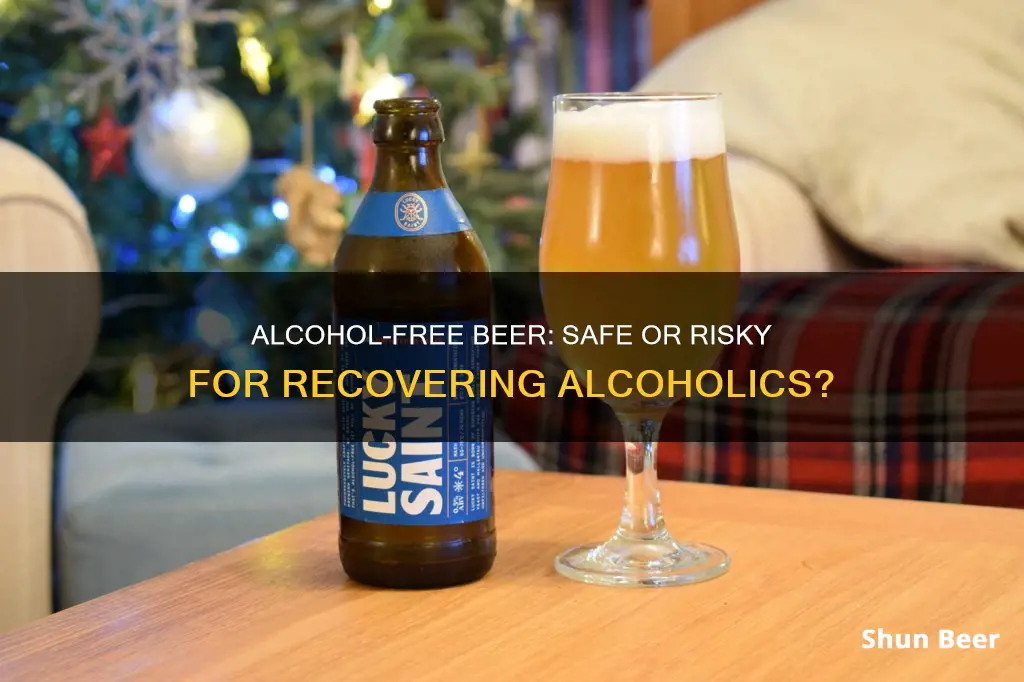
Alcohol-free beer has become a popular alternative for those recovering from alcohol addiction. However, the question of whether consuming non-alcoholic beer is considered breaking sobriety remains a subject of debate. While non-alcoholic beer typically contains minimal alcohol, often less than 0.5% alcohol by volume (ABV), it is crucial for those in recovery to understand their triggers and make informed decisions. Some individuals in recovery may find that non-alcoholic beer helps them feel included in social situations without compromising their sobriety. In contrast, others may view it as a trigger that reminds them of their past struggles with alcohol addiction. Ultimately, the decision to consume non-alcoholic beer during recovery is a personal one that should be made with careful consideration of individual circumstances and triggers.
| Characteristics | Values |
|---|---|
| Alcohol content | Non-alcoholic beer typically contains less than 0.5% alcohol by volume (ABV). However, some products may contain trace amounts of alcohol, and certain non-alcoholic beers can have up to 0.5% ABV. |
| Taste and appearance | Non-alcoholic beer is designed to taste and look like traditional beer. |
| Social benefits | Non-alcoholic beer allows recovering alcoholics to participate in social gatherings without feeling left out or pressured to consume alcoholic drinks. |
| Triggers and cravings | The taste and smell of non-alcoholic beer may trigger cravings and reminders of past drinking experiences, potentially leading to a relapse. |
| Individual variability | The impact of non-alcoholic beer varies among recovering alcoholics. Some individuals find it helpful, while others prefer to avoid it completely. |
| Professional guidance | It is recommended to consult healthcare professionals or support groups to determine if non-alcoholic beer is suitable during recovery. |
What You'll Learn

Non-alcoholic beer may still contain alcohol
Non-alcoholic beer is often marketed as a safe alternative to alcoholic beer. However, it is important to be aware of the risks before consuming it, especially for those with alcohol use problems and pregnant people.
Non-alcoholic beer is typically produced by removing the alcohol from regular beer. While this process eliminates most of the alcohol content, small amounts may still remain. Regular beer contains approximately 14 grams of alcohol, while non-alcoholic beer typically contains about one gram. By law, non-alcoholic beers can contain up to 0.5% alcohol by volume (ABV). However, products marketed as alcohol-free are required to have 0.0% ABV, meaning there are no detectable levels of alcohol.
Despite these regulations, research suggests that many non-alcoholic beers contain more alcohol than their labels indicate. A study found that 29% of tested no- or low-alcohol beers had higher alcohol levels than stated on their labels. Additionally, six beverages labelled as having 0.0% ABV were found to contain alcohol levels higher than one percent.
The presence of alcohol in non-alcoholic beer poses potential dangers, especially for certain populations. For example, people with liver impairments may experience significantly higher blood alcohol levels after consuming non-alcoholic beer, which may cause them to test positive on alcohol urine or breath tests.
Furthermore, the smell of non-alcoholic beer, which is very similar to regular beer, may trigger cravings and increase the risk of relapse among individuals with alcohol use disorder. According to the National Institute on Alcohol Abuse and Alcoholism, up to 90% of alcoholics will experience at least one relapse within four years of quitting drinking.
The potential presence of alcohol in non-alcoholic beer also has implications for pregnant individuals. The American College of Obstetrics and Gynecology (ACOG) recommends avoiding any alcohol consumption during pregnancy to eliminate the risk of fetal alcohol spectrum disorder (FASD). While FASD typically occurs with chronic high alcohol intake, there is no known safe amount of alcohol use during pregnancy, according to the Centers for Disease Control and Prevention (CDC).
In conclusion, while non-alcoholic beer may be a suitable option for some individuals looking to reduce their alcohol intake, it is important to be aware that it may still contain small amounts of alcohol. This is particularly relevant for pregnant individuals, those trying to become pregnant, and people with a history of alcohol use problems. The potential risks associated with non-alcoholic beer consumption include increased blood alcohol levels, positive alcohol tests, and triggering of cravings that may lead to relapse. Therefore, it is crucial to consider these factors and make an informed decision based on individual needs and circumstances.
Klonopin and Beer: Safe Mix or Not?
You may want to see also

The placebo effect of non-alcoholic beer
Non-alcoholic beer is often viewed as a safe alternative to regular beer, but it is important to be aware of the risks, especially for those recovering from alcohol use disorder. While non-alcoholic beer may not get you drunk, it can trigger a relapse in recovering alcoholics due to the placebo effect.
The placebo effect refers to the phenomenon where an individual experiences the effects of a substance, not due to its pharmacological action, but because of their expectation of those effects. In the context of non-alcoholic beer, the placebo effect can lead to a recovering alcoholic experiencing the psychological effects of intoxication without actually consuming alcohol. This can be dangerous as it can trigger a relapse.
The act of drinking a substance that resembles beer in taste, smell, and appearance can evoke powerful memories and expectations in a recovering alcoholic. The ritual of drinking, the taste, and the smell of beer can trigger "euphoric recall", bringing up memories of the good times associated with drinking. This can lead to cravings and increase the risk of relapse. Additionally, the social context of drinking, such as being at a party or with a group of friends, can further enhance the placebo effect.
The Risks of Non-Alcoholic Beer for Recovering Alcoholics
While non-alcoholic beers typically contain less than 0.5% alcohol by volume, they are not completely alcohol-free. This means that consuming a significant amount of non-alcoholic beer can still result in some alcohol intake, which may be dangerous for a recovering alcoholic. Additionally, research has shown that non-alcoholic beers may contain more alcohol than their labels indicate, with some samples containing over 1% alcohol.
Furthermore, the taste and smell of non-alcoholic beer can be very similar to regular beer, and this sensory experience can be a powerful trigger for those in recovery. The anticipation of alcohol can raise levels of dopamine, a brain chemical associated with pleasure and elation, which can further reinforce the placebo effect.
Making an Informed Decision
The decision to consume non-alcoholic beer during recovery is a personal one and should be based on an individual's triggers and comfort level. It is crucial to be aware of one's triggers and avoid high-risk situations. If non-alcoholic beer is a trigger, it is best to avoid it. However, for some, non-alcoholic beer can provide a sense of inclusion and normalcy without leading to a relapse. It is important to assess your own recovery journey and make an informed decision.
Final Thoughts
While non-alcoholic beer can be a helpful option for some, it is not without risks for recovering alcoholics. The placebo effect demonstrates how powerful our expectations and sensory experiences can be in shaping our physiological and psychological responses. Therefore, it is crucial for those in recovery to carefully consider their relationship with non-alcoholic beer and make choices that support their long-term sobriety.
Beer and Pseudoephedrine: A Safe Mix?
You may want to see also

The risks of non-alcoholic beer for pregnant people
Non-alcoholic beer is often marketed as a safe alternative to alcoholic drinks, but it is essential to be aware of the risks, especially if you are pregnant or trying to become pregnant. Even though non-alcoholic beer contains very little or no alcohol, it is not entirely free of alcohol. In the US, non-alcoholic beers can contain up to 0.5% ABV, and some products may contain more alcohol than advertised. Research has shown that some non-alcoholic beers had higher alcohol levels than stated on their labels, and some alcohol-free beers were found to contain more than 1% ethanol.
The American College of Obstetrics and Gynecology (ACOG) recommends that pregnant individuals should avoid drinking any alcohol to eliminate the risk of fetal alcohol spectrum disorder (FASD). FASD can cause low body weight, facial abnormalities, physical problems, and neurobehavioral disorders in the baby. The Centers for Disease Control and Prevention (CDC) also states that there is no known safe amount of alcohol use during pregnancy. Therefore, it is best to avoid non-alcoholic beers during pregnancy or when trying to conceive, as they may still contain small amounts of alcohol that could potentially harm the fetus.
In addition to the risks associated with alcohol content, the smell of non-alcoholic beer may also be a trigger for people with alcohol use disorder. The ritual around drinking and the taste and smell of beer, even non-alcoholic beer, may be enough to trigger a relapse. The best advice for those trying to maintain sobriety during pregnancy is to avoid anything that smells like alcohol.
Beer and Abs: Is It Possible to Have Both?
You may want to see also

The pros and cons of non-alcoholic beer as a harm-reduction tool
Non-alcoholic beer is often marketed as a safe alternative to alcoholic drinks, but it may not be the best option for everyone, especially those with alcohol use problems. While non-alcoholic beer typically contains very little alcohol, it is not completely alcohol-free and may still pose risks for people in recovery from alcohol use disorder.
The Pros
Non-alcoholic beer can be a useful harm-reduction tool for people looking to reduce their alcohol intake or maintain sobriety. Here are some potential benefits:
- It allows people to enjoy the taste of beer without the negative consequences of alcohol. This can be especially appealing to those who enjoyed the taste of beer before their drinking became problematic.
- It provides a social alternative for people who want to join in with friends at social events where alcohol is served without feeling left out or pressured to drink.
- It can be a healthier option than alcoholic beer, as it typically contains fewer calories and may even offer some health benefits, such as reduced inflammation and improved recovery after exercise.
- It can be a good alternative for pregnant people who want to reduce their alcohol intake, as long as they choose products that truly have no alcohol.
The Cons
However, there are also several potential drawbacks and risks associated with non-alcoholic beer:
- It may not be completely alcohol-free. By law, non-alcoholic beers can contain up to 0.5% alcohol, and some products may contain even more than that. This can be a problem for people who are sensitive to even small amounts of alcohol, such as those with liver impairments or who are pregnant.
- The smell and taste of non-alcoholic beer can trigger cravings and increase the risk of relapse for people with alcohol use disorder. The psychological effects of drinking a beer-like beverage can be a powerful trigger, even if the drink itself contains little to no alcohol.
- It may not be a sustainable solution for people in recovery. While it can provide a temporary alternative, the risk of relapse may be heightened if the underlying issues driving the person's drinking are not addressed.
- It may not be easily accessible. In many social situations, the only non-alcoholic options available may be soft drinks or sugary cocktails, which some people may want to avoid for health reasons.
Overall, non-alcoholic beer can be a helpful harm-reduction tool for some people, but it is not without its risks. It is essential for individuals to make informed decisions about their consumption of non-alcoholic beer based on their personal triggers, comfort level, and recovery journey.
Drinking Beer in a Moving Car: What's Allowed for Passengers?
You may want to see also

The potential for non-alcoholic beer to trigger cravings and a relapse
Non-alcoholic beer is often presented as a safe alternative to alcohol, but it is important to be aware of the risks before consuming it. While non-alcoholic beer might be a good option for some people, it can pose dangers, especially for those with alcohol use problems.
The smell and taste of non-alcoholic beer
Non-alcoholic beer often smells and tastes similar to regular beer. The smell of beer may be enough to trigger cravings and a subsequent relapse among certain people with alcohol use disorder. A team of California scientists reported that the smell of beer may increase the levels of dopamine, a brain chemical that plays a role in feelings of elation and pleasure, in the brains of people with alcohol use disorder.
"Euphoric recall"
The non-profit recovery organization, the Stout Street Foundation, states that tasting beer can trigger "euphoric recall", or the memories of the good times of drinking. For people with alcohol use disorder, part of the disease is having difficulty remembering or acknowledging the negative consequences of drinking.
Individual differences
Whether non-alcoholic beer will trigger cravings and a relapse depends on the individual. Some people in recovery may be at risk for relapse due to the concept of "near beer" or artificial spirits, which look and taste like the real thing. On the other hand, some people in recovery may feel safe drinking non-alcoholic beer and find that it helps them feel included in social events where alcohol is served.
Strategies for avoiding relapse
- Know your triggers and stay away from them.
- Avoid high-risk situations by keeping little or no alcohol at home and avoiding activities involving drinking.
- If you can't avoid high-risk situations, remind yourself of your reasons for staying sober, talk to a trusted friend, or distract yourself with a healthy activity.
- If you feel a craving coming on, ride it out – cravings are short-lived and will pass in a few minutes.
Whiskey and Beer: A Dangerous Cocktail?
You may want to see also
Frequently asked questions
Non-alcoholic beer is designed to taste and look like traditional beer but contains very minimal or no alcohol. While it can be a viable alternative for individuals who want to enjoy the taste and social experience of drinking beer without the intoxicating effects of alcohol, it may still trigger cravings or emotional associations for individuals with a history of alcohol addiction. The decision to consume non-alcoholic beer during recovery is a personal one and should be made after assessing one's triggers and consulting with healthcare professionals or support groups.
Despite being marketed as "non-alcoholic", these beverages may still contain trace amounts of alcohol. More importantly, the taste and smell of non-alcoholic beer can trigger cravings and reminders of past drinking experiences, potentially leading to a relapse. The concept of "near beer" may also blur the lines between sobriety and consumption, making it difficult for recovering alcoholics to maintain their commitment to abstinence.
Non-alcoholic beer can be a useful tool for individuals in recovery to navigate social situations and participate in gatherings without feeling left out or pressured to consume alcoholic beverages. It provides a sense of normalcy and inclusivity. However, it is crucial to be mindful of triggers and make informed decisions. Some individuals in recovery may prefer to avoid any beverage that resembles alcohol to maintain their sobriety.
Alternatives to non-alcoholic beer include soda with fresh lime juice or fresh fruit. Additionally, making lifestyle changes, such as eating a balanced diet, engaging in regular physical activity, getting enough sleep, and finding healthy hobbies and leisure activities, can support sobriety and long-term recovery. Building a strong support system and seeking professional guidance when needed are also crucial for maintaining abstinence.







